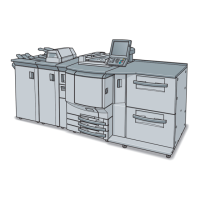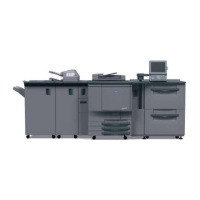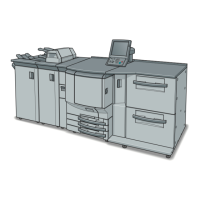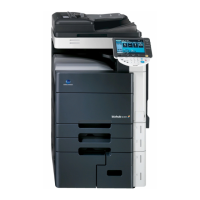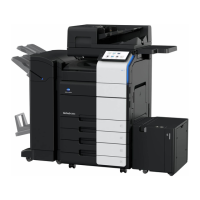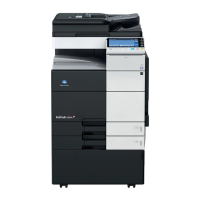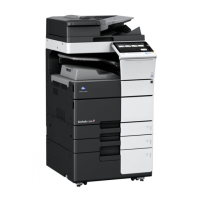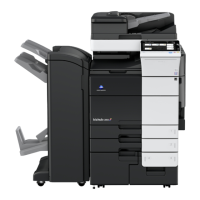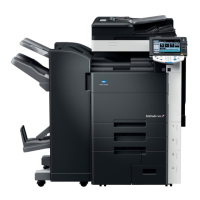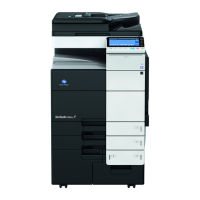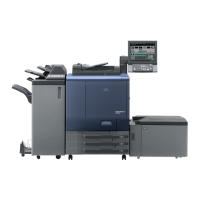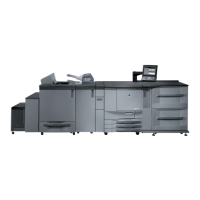
Do you have a question about the Konica Minolta bizhub pro C6501 and is the answer not in the manual?
| Print Speed (Color) | 65 ppm |
|---|---|
| Print Speed (Black) | 65 ppm |
| Monthly Duty Cycle | 300, 000 pages |
| Scanning | Yes |
| Dimensions | 1, 280 x 1, 020 x 1, 200 mm |
| Weight | 240 kg |
| Duplex Printing | Yes |
| Print Resolution | 1200 x 1200 dpi |
| Connectivity | Ethernet, USB |
| Paper Capacity | 3, 150 sheets |
| Scanner Type | Color Scanner |
| Scanner Resolution | 600 dpi |
| Copy Speed | 65 ppm |
Detailed instructions on operation, maintenance, and precautions for safe use of the machine.
Explanation of safety precaution notations and labels appearing on the machine and in the manual.
Procedure for turning the main and sub power switches on and off.
Procedure for loading various types of paper into machine trays and feeders.
Step-by-step guide for replacing toner bottles to maintain print quality.
Procedure for safely exchanging the toner recovery box when it becomes full.
Instructions for replacing staple cartridges in various finishers and saddle stitchers.
Procedure for adding paste pellets to the Perfect Binder PB-501/PB-502.
Procedure to follow when the 'Please Call Service C-####' message is displayed.
Troubleshooting steps for clearing stuck paste pellets in the paste hopper.
Procedure for removing misfed paper and clearing paper jams from the machine.
Identifying and resolving issues indicated by the blinking orange [MACHINE] tab.
Addressing memory overflow errors that stop machine operation.
Procedure to resolve issues indicated by the 'Please turn power Off/On' message.
Instructions for cleaning key components like the original glass, ADF guide cover, and external surfaces.
Action to take when the 'Receiver exchange' message is displayed, requiring service.
Information on required preventive maintenance based on copy volume for optimal performance.
Safety and handling precautions for paste pellets and the perfect binder.
Step-by-step guide for performing a basic copy job, including positioning originals and setting conditions.
Instructions for placing originals correctly in the ADF or on the original glass for scanning.
How to stop a job in progress (scanning, printing, or both) and manage suspended jobs.
Specifying original types and binding direction for copying jobs.
Dividing and scanning large amounts of originals into memory as a single job.
Changing magnification ratios using proportional, individual, enlarge/reduce, or set zoom modes.
Setting copy modes for single-sided or double-sided copies from various original types.
Making single-sided copies from double-sided originals using ADF and 2->1 mode.
Configuring paper size, type, weight, and other specifications for each paper tray.
Setting up new jobs while a current job is in process for immediate printing upon completion.
Methods for modifying colors using adjustments like density, hue, saturation, and brightness.
Manually adjusting copy density for darker or lighter images.
Creating multiple page signature booklets, folded and stapled, using scanned originals.
Scanning multiple sets of originals with different settings and outputting as a complete set.
Printing built-in stamps, numbering, date/time, watermark, or copy protect onto copies.
Output modes for primary and secondary trays, including non-sort, collate, uncollate, and staple.
Selecting stapling position and number of staples for output to the primary (main) tray.
Using Folding Unit FD-503 for punch and various folding patterns like Z-Fold or Tri-Fold.
Creating multiple page signature booklets, folded and stapled, using Booklet Pagination and Saddle Stitcher.
Making perfect-bound books by attaching covers and body sets, including binding direction and trimming.
Selecting stapling position and number of staples for output to the primary (main) tray of Finisher FS-520.
Selecting stapling position and number of staples for output to the primary (main) tray of Finisher FS-607.
Creating folded or folded & stapled booklets using Saddle Stitcher SD-506.
Producing a sample copy to review copying selections before making multiple copies.
Temporarily interrupting a current job to perform a simple job and then resuming the previous one.
Storing frequently used copy job settings for later recall.
